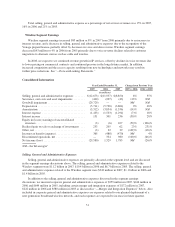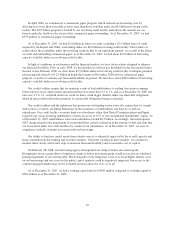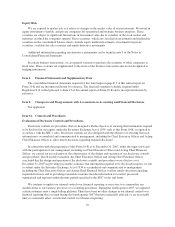Sprint - Nextel 2007 Annual Report Download - page 62
Download and view the complete annual report
Please find page 62 of the 2007 Sprint - Nextel annual report below. You can navigate through the pages in the report by either clicking on the pages listed below, or by using the keyword search tool below to find specific information within the annual report.goodwill or intangible assets resulting from the acquisitions. Any adjustment to the valuation allowance after
2008 would be recorded to the statement of operations following the guidance in the recently issued SFAS
No. 141R, Business Combinations, described in further detail in Significant New Accounting Pronouncements.
We adopted FASB Interpretation No. 48, or FIN 48, Accounting for Uncertainty in Income Taxes,an
interpretation of SFAS No. 109, Accounting for Income Taxes, on January 1, 2007. The adoption of FIN 48 did
not have a material impact on our consolidated financial statements. The accounting estimates related to the
liability for uncertain tax positions require us to make judgments regarding the sustainability of each uncertain
tax position based on its technical merits. If we determine it is more likely than not a tax position will be
sustained based on its technical merits, we record the impact of the position in our consolidated financial
statements at the largest amount that is greater than fifty percent likely of being realized upon ultimate
settlement. These estimates are updated at each reporting date based on the facts, circumstances and information
available. We are also required to assess at each reporting date whether it is reasonably possible that any
significant increases or decreases to the unrecognized tax benefits will occur during the next twelve months. See
note 7 of the Notes to Consolidated Financial Statements for additional information regarding FIN 48. Our
liability for uncertain tax positions was $654 million as of December 31, 2007.
Actual income taxes could vary from these estimates due to future changes in income tax law, significant
changes in the jurisdictions in which we operate, our inability to generate sufficient future taxable income or
unpredicted results from the final determination of each year’s liability by taxing authorities. These changes
could have a significant impact on our financial position.
Significant New Accounting Pronouncements
Fair Value Accounting Pronouncements
In September 2006, the FASB issued SFAS No. 157, Fair Value Measurements. This statement changes the
definition of fair value, as defined by previous statements, to “the price that would be received to sell an asset or
paid to transfer a liability in an orderly transaction between market participants at the measurement date.”
Additionally, this statement establishes a hierarchy that classifies the inputs used to measure fair value. In
February 2007, the FASB issued SFAS No. 159, The Fair Value Option for Financial Assets and Financial
Liabilities. This statement allows entities the choice to measure certain financial instruments and other items at
fair value on specified measurement dates and report any unrecognized gains or losses in earnings and serves to
minimize volatility in earnings that occurs when assets and liabilities are measured differently without having to
apply complex hedge accounting provisions. Both SFAS No. 157 and SFAS No. 159 are effective for our
quarterly reporting period ending March 31, 2008, however in February 2008, the FASB issued a FASB Staff
Position to partially delay the effective date of SFAS No. 157 for all nonfinancial assets and nonfinancial
liabilities, except those that are recognized or disclosed at fair value in the financial statements on a recurring
basis, until fiscal years beginning after November 15, 2008.
Based on the FASB Staff Position noted above, the partial adoption of SFAS No. 157 will not have a
material impact on our financial position and results of operations in 2008. We are still assessing the impact that
SFAS No. 157 will have on our nonrecurring measurements for nonfinancial assets and liabilities in 2009. Upon
the partial adoption of SFAS No. 157 in the quarterly period ending March 31, 2008, we expect to have
additional disclosures in the notes to our consolidated financial statements for certain recurring fair value
measurements. We are continuing to evaluate the impact of the FASB Staff Position noted above as it relates to
the disclosure of our nonrecurring fair value measurements, such as our annual impairment review of our
goodwill and FCC licenses, and it will require significant disclosures related to our key assumptions and
variables used in these analyses. We do not plan to elect the fair value option under the provisions of SFAS
No. 159 for eligible financial assets and liabilities held on January 1, 2008; however, we will apply the fair value
provisions of that statement for all eligible assets and liabilities subsequently acquired or modified on or after
January 1, 2008.
60
























